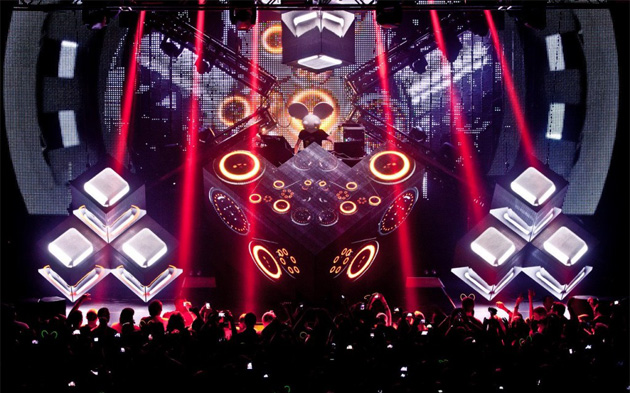 The stadium or the outdoor festival is allegorical in EDM’s history. In the 1990s, just as the genre started to take off, larger venues symbolized just how far its performers have come. The bowl-shaped concert hall, holding thousands and placing the DJ front and center, became the apex. But, in the present, these venues represent the bloated, over-commercialization of the genre, the over-extended sound, and performers not cut out for six-hour club sets. Essentially, it’s EDM’s success and failures rolled into a single image.
The stadium or the outdoor festival is allegorical in EDM’s history. In the 1990s, just as the genre started to take off, larger venues symbolized just how far its performers have come. The bowl-shaped concert hall, holding thousands and placing the DJ front and center, became the apex. But, in the present, these venues represent the bloated, over-commercialization of the genre, the over-extended sound, and performers not cut out for six-hour club sets. Essentially, it’s EDM’s success and failures rolled into a single image.
Jesse Saunders, one of house music’s founders, aimed to take the genre back to its roots with his Pure House Music Festival, which played at the Clark County Government Center Amphitheater in downtown Las Vegas. Saunders, still a producer and DJ himself, took a different approach with his festival. Influenced early in his career by Kraftwerk, the Chicago house DJ put together a lineup of DJs, live musicians, and singers – and one that considerably contrasts with the overly-commercial sounds of the city’s Strip area, a growing mainstream EDM mecca of major names and bottle service.
Saunders, while nodding toward the success of David Guetta and other successful DJs/producers in a recent interview, understands that the genre’s origins are being glossed over for slick production, pop star collaborations, and grandiose sets. Playing a six-hour set in a club is practically minimal and low-key in comparison. The Pure House Music Festival, instead, acknowledges the genre’s origins. But, between the genre’s earliest form and a David Guetta pop track, house has evolved, for better and for worse, but can a balance be achieved?
EDM has evolved from its smooth, brassy disco origins into the wobbles of dubstep. While these two bookends bear minimal resemblance to each other, they represent steps on a path that has moved through synth-pop, house, trance, Euro-dance, electro, and many more subgenres, all influenced by outside sounds, new technologies, and equipment. Guetta’s brand of pop house may arguably be a sonic retrogression, rather than a move forward, while others may view it has the harbinger of EDM’s most mainstream wave.
Like the stadium, Guetta’s output is both a negative and positive symbol in the genre’s history. In a decade from now, critics and musicologists may decree the French producer as the genre’s nail in the coffin or a great innovator, just as disco and trance were reviled in their respective time periods but are now moderately respected for their influence.
But, Guetta is not the sole point defining the genre’s potential evolution. As we’ve pointed out, younger producers view house or dubstep as the jumping point for creating film scores. Older, more established DJs, like Paul Oakenfold, BT, Junkie XL, Daft Punk, and Paul Van Dyk, are already dabbling in this medium. On the other hand, such more established performers acknowledge EDM is a continuum – one in which new and old sounds influence each other. Exclusivity is passé, and the ability to transition from one genre to the other is revered.
What do you think is EDM’s next step in its evolution? Could it be as a collective melting pot of all genres?



